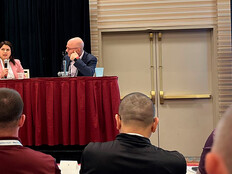“We have benchmarks and review criteria for our program,” Kron says. “We advise on which programs are priorities for development, and we test and evaluate vendor products under consideration.”
The office has driven recent accessibility improvements throughout the NSA, including providing automated captioning in its auditorium and improving the resolution of its video service. In addition, a pilot is being run to test secure, on-demand text-to-speech and speech-to-text technology to assist employees with hearing disabilities.
The NSA is also tackling a particularly difficult accessibility challenge: multifactor authentication. With two-step authentication, the second piece of authentication is usually generated on a smartphone, but those are not permitted in sensitive compartmented information facilities, so intelligence agencies generally use tokens with codes instead. However, those tokens are often not accessible for employees who are blind or have low vision, and outside the SCIF, standard smartphones are not accessible for some workers with disabilities.
“We’ve been challenged to find accessible authentication that doesn’t require access to the internet because that is a security risk,” Kron says. “We have some fascinating pilots right now looking at this challenge.”













